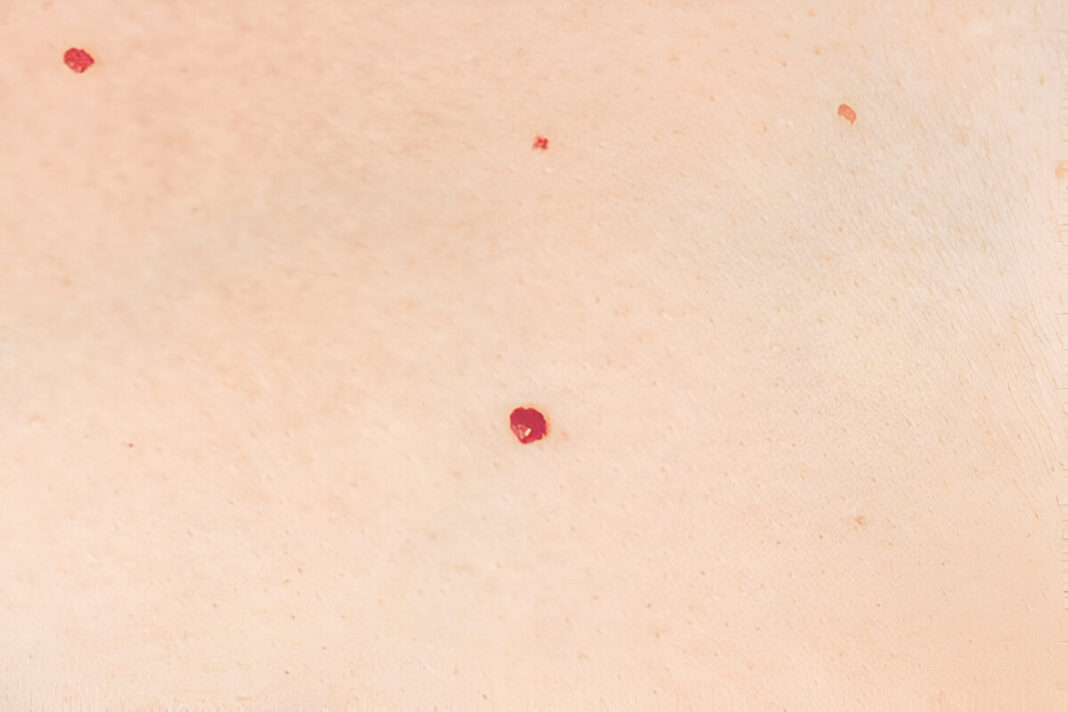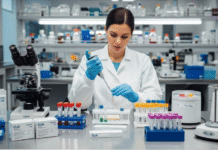If you’ve ever noticed small, bright red spots popping up on your skin, you might have come across cherry angiomas. These tiny, ruby-colored skin marks can seem alarming at first, but they are actually quite common and usually harmless. Let’s take a closer look at what cherry angiomas are, why they appear, and what you can do about them if they bother you.
What Are Cherry Angiomas?
Cherry angiomas, sometimes called “red moles,” are small, benign (non-cancerous) growths made up of clusters of tiny blood vessels. They typically appear as bright red, smooth, or slightly raised spots on the skin. The name “cherry” comes from their rich red color, resembling a ripe cherry fruit. These angiomas usually range in size from a pinpoint to about a quarter of an inch in diameter (Harrison, 2018).
They most commonly show up on the trunk (chest and back), but can also appear on the arms, legs, and sometimes the face. While anyone can develop cherry angiomas, they are more frequent in adults over 30 and tend to increase in number with age (James et al., 2018).
Why Do Cherry Angiomas Appear?
The exact cause of cherry angiomas is not fully understood, but several factors seem to contribute:
- Age: Cherry angiomas become more common as people get older. By the age of 70, most individuals have several of these spots (Harrison, 2018).
- Genetics: If your parents have cherry angiomas, you might be more likely to develop them too (Zachariae & Kragballe, 2017).
- Hormonal Changes: Pregnancy or other hormonal shifts can sometimes trigger their appearance (Morales-Pérez et al., 2020).
- Certain Chemicals: Some studies suggest exposure to specific chemicals, like bromides, may be linked to their development (James et al., 2018).
It is important to note that cherry angiomas are not caused by sun exposure, unlike other skin spots such as freckles or age spots (Harrison, 2018).
Are Cherry Angiomas Dangerous?
For most people, cherry angiomas are purely cosmetic and do not cause pain or discomfort. They are benign and do not turn into skin cancer. However, if a spot starts to bleed easily, grows rapidly, or changes color, it is wise to consult a dermatologist. These changes could indicate other skin issues that need professional evaluation (Harrison, 2018; Bolognia, Schaffer, & Cerroni, 2017).
When and How to Manage Cherry Angiomas
Since cherry angiomas are harmless, many people choose to leave them alone. But if they are itchy, bleeding, or just bothersome in appearance, there are several ways to manage or remove them.
- Dermatological Treatments
Laser Therapy: One of the most common methods, laser treatment targets the blood vessels in the angioma, causing them to shrink and fade. It is quick, minimally invasive, and usually requires little recovery time (Morales-Pérez et al., 2020).
Electrocautery: This method uses heat from an electric current to burn off the angioma. It is effective but might cause slight scarring (James et al., 2018).
Cryotherapy: Freezing the angioma with liquid nitrogen can destroy it, but this method is less commonly used for cherry angiomas than for other skin lesions (Bolognia et al., 2017).
- Home Care and Natural RemediesWhile no scientifically proven home remedies exist for cherry angiomas, some people try gentle skin care practices to maintain overall skin health. Avoid picking or scratching the spots, as this can lead to bleeding or infection. Maintaining a balanced diet rich in antioxidants and staying hydrated supports healthy skin but will not eliminate cherry angiomas (Sarkar & Kaur, 2019).
- When to See a Doctor
If you notice new angiomas appearing rapidly or if any spot starts to bleed without clear cause, it is best to see a dermatologist. A professional can safely diagnose and treat your skin concerns, ensuring nothing more serious is going on.
Living With Cherry Angiomas
Cherry angiomas are often part of the natural aging process and do not impact health. Many people find them to be a minor cosmetic nuisance at worst. If you do decide to have them removed, modern dermatology offers safe and effective treatments that can restore your confidence in your skin’s appearance.
Remember, skin changes are a normal part of life. Paying attention to how your skin evolves and consulting with healthcare professionals when you notice unusual changes helps keep your skin and you healthy.
References
- Bolognia, J. L., Schaffer, J. V., & Cerroni, L. (2017). Dermatology (4th ed.). Elsevier.
- Harrison, D. (2018). Common benign vascular skin lesions: Cherry angiomas. Dermatology Times, 39(6), 20-22.
- James, W. D., Berger, T. G., Elston, D. M., & Andrews, G. C. (2018). Andrews’ Diseases of the Skin: Clinical Dermatology (13th ed.). Elsevier.
- Morales-Pérez, E., García-García, E., & Bonifaz, A. (2020). Clinical management of cherry angiomas: A review. Journal of Cutaneous Medicine, 45(2), 89-95.
- Sarkar, R., & Kaur, S. (2019). Role of nutrition in skin health. Indian Journal of Dermatology, 64(2), 120-127.
- Zachariae, C., & Kragballe, K. (2017). Genetic factors in skin aging and benign vascular lesions. Journal of Dermatological Science, 85(1), 12-18.











